How To Grow Walnut Trees (Complete Planting Guide)
You can grow walnut trees from both seeds and seedlings. However, growing them from seeds is a lot of work. It is easier to buy a germinated plant and grow it further with good care.
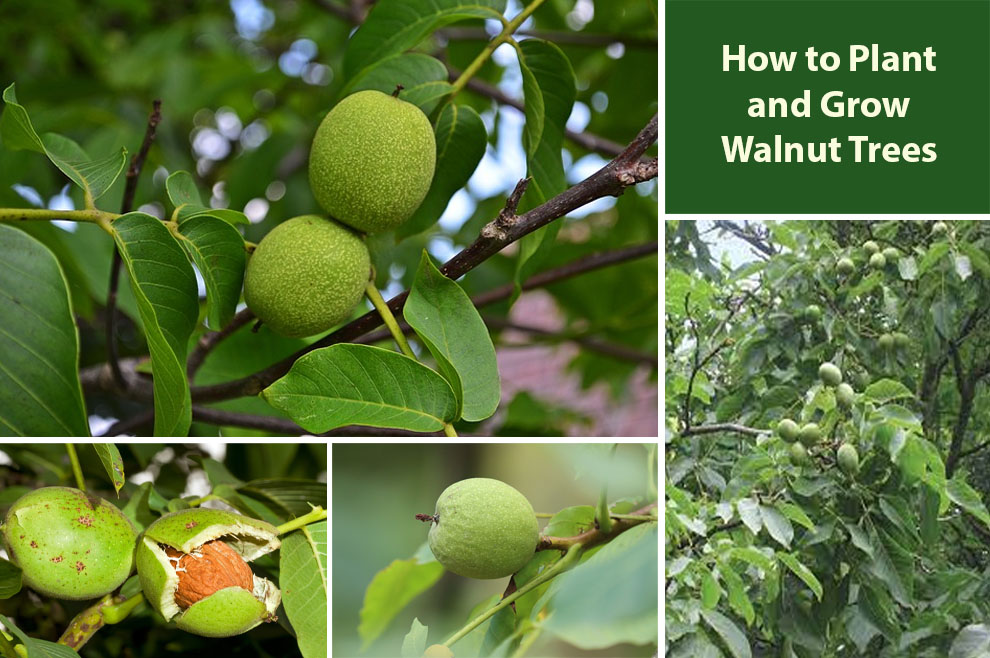
Walnuts have rich nutritional value and a unique flavor for which they are highly sought after. While you must be aware of how to grow walnut trees, know that they do not grow equally well in all areas.
Walnut trees need a suitable location with full sunlight and well-drained soil. You must ensure enough spacing between walnut trees and other plants to protect the nearby plants from the toxic liquid produced by Walnut trees.
Once planted, water the walnut trees regularly to ensure the soil stays moist but not waterlogged. Add a thick mulch layer to conserve moisture and suppress weeds.
Pruning is vital to give shape to the trees and remove damaged branches. Regularly monitor the plants for diseases and pests and promptly address any issues.
Be patient. It takes several years for walnut trees to reach maturity and bear a bountiful harvest, rewarding you with healthy and delicious nuts.
Walnut Tree Planting Guide
| Plant type | Deciduous Tree |
| Walnut tree growing zone | USDA zones four through nine |
| Planting time | Fall |
| Germination time | 12 to 15 weeks |
| Nut production (years) | 7-10 years |
| Soil type and pH | Fertile, well-drained soil. |
| Temperature | Below 25 °C (77 °F) with low humidity |
| Sunlight exposure | Full sun or partial shade. |
| Watering frequency | Deep but infrequent to keep the soil moist |
| Fertilizers | Slow-release high nitrogen fertilizer with ammonium sulfate |
Can You Grow A Walnut Tree From A Walnut?
Yes.
You can grow walnut trees from walnut, but please note that germinating a walnut seed can be time-consuming, and the success rate is typically low.
If you wish to do this, begin the drill by gathering fresh walnuts in the fall to amplify your chances.
Typically, it takes several months for the seeds to germinate, and not all seeds sprout. Perseverance and patience are pivotal when growing walnut trees from a walnut.
Method 1 – How To Grow Walnuts From Seed?
It is possible to grow walnuts from seeds, but it demands patience. Below we will take you through the detailed guide. The chances of success are high if you follow the process to the T.
A. Walnut seed collection
It is a crucial step in growing walnut trees from the seeds. Harvest the fresh walnuts in the fall when fully ripe, and look for walnuts that have naturally fallen from the trees.
Alternatively, gently shake the branches to collect the mature walnuts. Remove the outer husk by wearing gloves and place the walnuts in a water bucket. Let it sit for a day or two. It softens the husk, making it easier to remove.
Next, rinse the walnuts and let them dry before you can store them in a cool, dry place until they are ready for planting. Exercising care and caution at this stage will help ensure healthy and viable walnut seeds for successful germination.
B. Walnut seed preparation (stratifying)
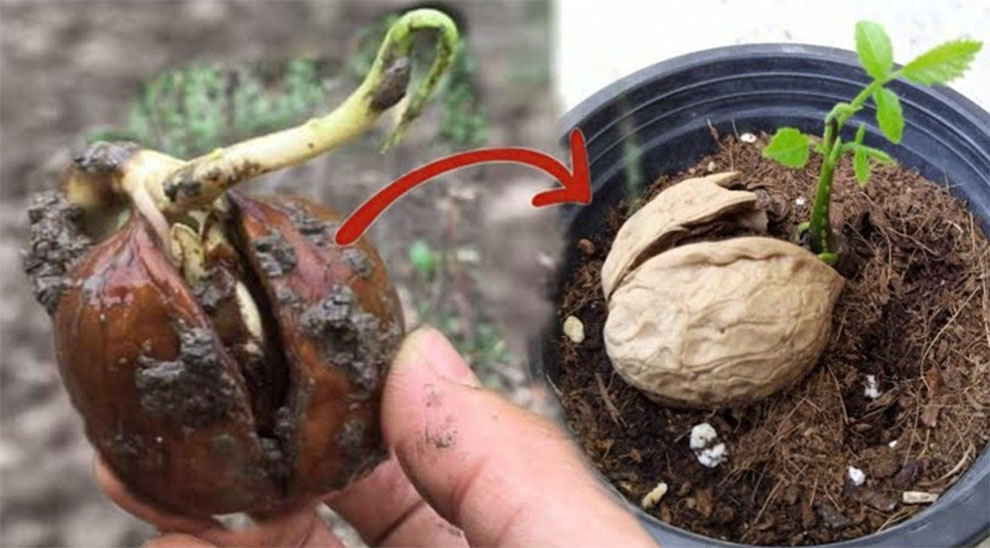
Once you have collected the seeds, you are ready for the second step in the how to grow walnut trees from seeds guide: Seed preparation or stratifying. Stratification involves stimulating the natural conditions necessary for seed germination.
Follow the steps below for stratification:
- Begin by dampening a paper towel and placing the walnuts inside it.
- Seal the moistened paper towel with the nuts in a container or paper towel.
- Store it in a refrigerator for 90 to 120 days. It mimics the cold temperatures necessary for seed dormancy breakage.
- Inspect the moisture level of the paper towel regularly to ensure it stays moist but not soaked.
This stratification process readies your walnut seeds for successful germination by replicating their natural growth cycle.
C. Look out for walnut seed germination
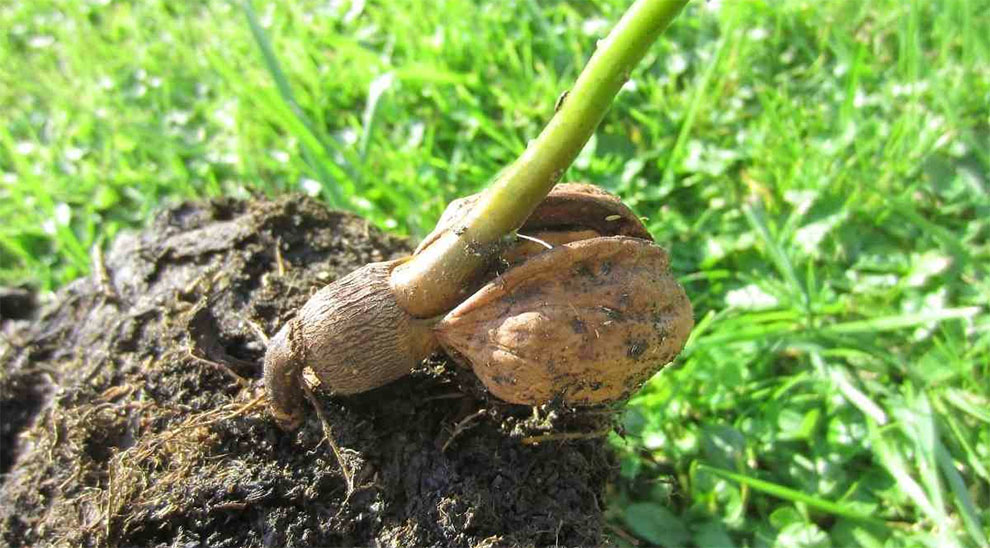
After the stratification period, you must look out for germination. It is a crucial stage in growing walnut trees and can take several weeks to months. Look for the emergence of a shoot or root from the seed.
After you see these signs, it means the germination has begun. Not all walnut trees germinate, and the germination rate may also vary. But by providing proper moisture, sun, and suitable soil, you can improve your chances of success.
Patience is the key, as germination is usually a tedious process. You can regularly monitor the seeds and provide the necessary care and attention to ensure their healthy growth and development.
D. Planting the walnut seeds
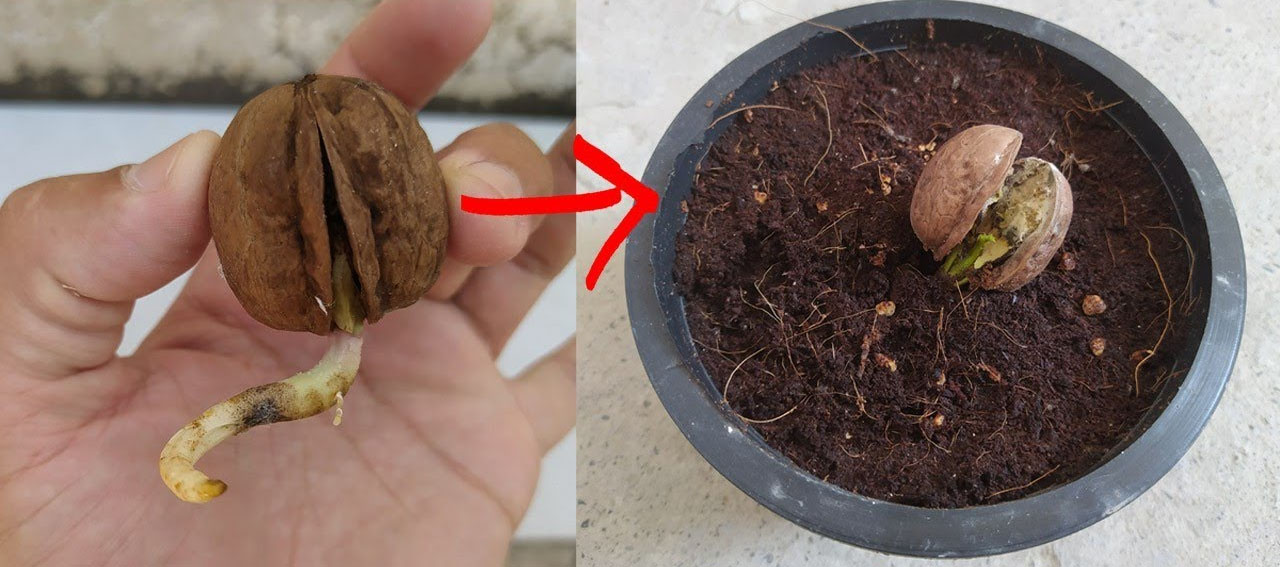
Once the seeds sprout, you can plant the walnut seeds directly in the ground or the containers, depending on your preferences. Pick a location ideal for planting. Ensure the soil is well-drained and rich in organic matter. Keep the soil moist, not waterlogged.
Provide the seeds with partial shade or full sun. Dig holes deep and wide to accommodate the seeds, ideally about one to two inches deep. Insert the seeds in the hole and cover them with the soil, gently pressing them down.
Maintain adequate spacing between the seeds, allowing enough room to grow. Water the newly planted seeds to settle the soil around them.
E. Watering the planted seeds
The last step in this walnut tree planting guide is adequately watering the planted seeds. It helps promote healthy growth. So maintain consistent moisture in the soil, but do not overwater.
Water the seeds deeply, allowing the water to penetrate the root zone. Regularly inspect the moisture levels, especially during the dry periods, and alter the watering frequency according.
Finally, mulch around the seedlings to retain moisture and avoid weed growth.
Method 2- How To Plant Walnut Tree Seedlings?
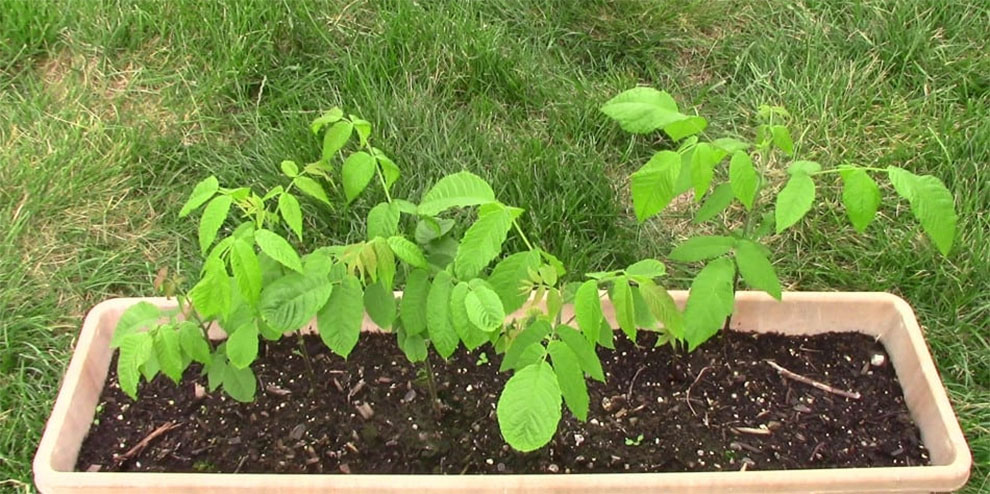
Instead of seeds, you may buy walnut seedlings to plant either online or from a nursery. Here are the steps you need to follow to plant the walnut seedlings:
1. Prep the soil: Pick a location with well-drained soil rich in organic matter. Loosen the soil and eliminate any grass or weeds from the planting area.
2. Dig a hole wide and deep enough to accommodate the seedlings’ root system. This hole must be somewhat larger than the seedling’s container.
3. Remove the seedling from the pot cautiously, ensuring not to damage the roots.
4. Insert the seedling in the hole: Position the seedling to rest it in the center of the hole. Further, ensure the trunk’s base is at par with or slightly above the soil surface.
5. Backfill the hole with soil, gently firming it around the seedlings’ roots. Do not compact the soil too tightly, as it can curtail root growth.
6. Water the seedlings to settle the soil and ensure good root-to-soil contact. Regularly water the plants to keep the soil moist.
7. Mulch around the seedling, leaving a small space around the trunk to avoid root rot or moisture build-up.
8. Provide ongoing care: Water the seedling regularly, ensuring the soil remains moist and not waterlogged. Inspect for diseases and pests and apply regular treatments as needed. Prune the seedling as necessary to promote a balanced and robust structure.
When Should Walnut Trees Be Planted (Both Seedlings Or Seeds)?
Typically, plant the walnut trees during the dormant season: early winter or late fall. During this period, walnut trees are less susceptible to transplant shock and can grow a robust root system more effectively.
Please note that walnut seeds demand a stratification period or cold treatment before planting. It usually takes 90-120 days.
So, trust us when we tell you how to plant walnut trees from seeds. Make sure to commence the stratification process in early fall or late summer to prep the seeds for planting in the dormant season.
How Far Apart To Plant Walnut Trees?
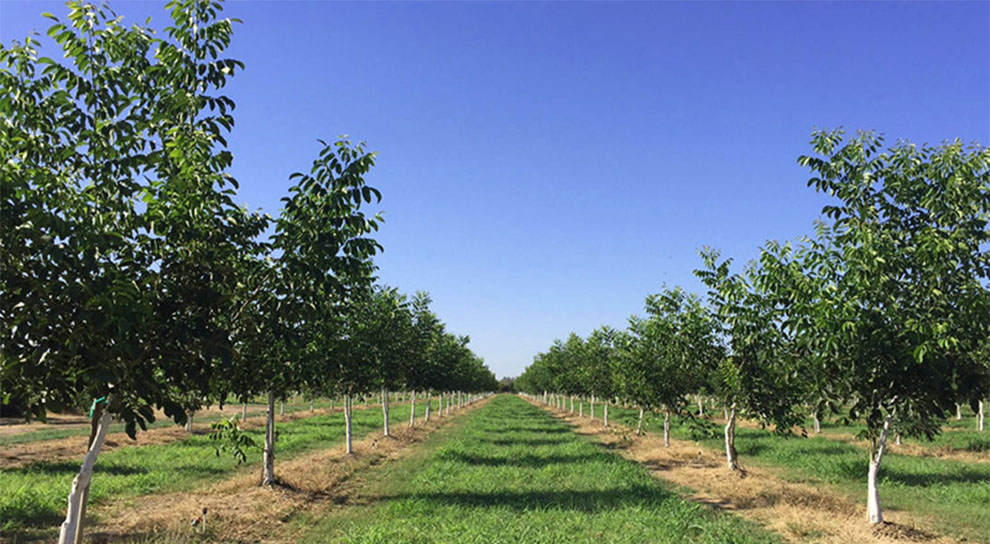
When planting walnut trees, you must maintain ample spacing for their growth and development. The recommended planting distance can vary depending on the variety grown and the intended purpose for planting.
But typically, you can space the walnut trees approximately 30 to 40 feet apart. It gives the canopy ample room to expand and receive adequate air circulation and sunlight.
Further, providing enough space is also necessary to prevent competition in nutrients and lower the risk of diseases spreading between the closely grown trees.
Related: How to grow hazelnuts?
Considerations and Tips On Growing Walnuts
Below, we will cover important considerations and tips for successful walnut tree cultivation.
A. Choosing the Right Walnut Tree Variety
Picking the correct walnut variety is imperative for successful growth. Consider factors like desired nut characteristics, climate suitability, and tree size. The two most commonly grown species include Black walnuts with a long lifespan and Persian or English walnuts.
You can scour through different walnut species, read about them, or consult a local expert to know which walnuts work and thrive in your location.
B. What Type of Soil Is Best for Walnut Trees?
Walnuts prefer well-drained, fertile, loamy, and deep soil. The soil must have a pH between 6 and 7.5. Loam or sandy soils with good organic matter is best suited for walnuts.
Do not grow them in heavy clay soils, as they retain excess moisture. We recommend performing a soil assessment test to understand the soil’s composition and make amends to build an optimal growing condition for your walnuts.
C. How Often Should You Water Walnut Trees?
Watering frequency depends on several factors, such as tree age, soil type, and climate. Generally, walnuts prefer infrequent but deep watering to help with root growth. Established walnut trees cherish watering every seven to ten days in the hot weather.
Regularly inspect the soil moisture levels and alter the frequency as required to maintain consistent moisture sans overwatering.
D. Juglone In Walnuts – Where To Plant Walnut Trees?
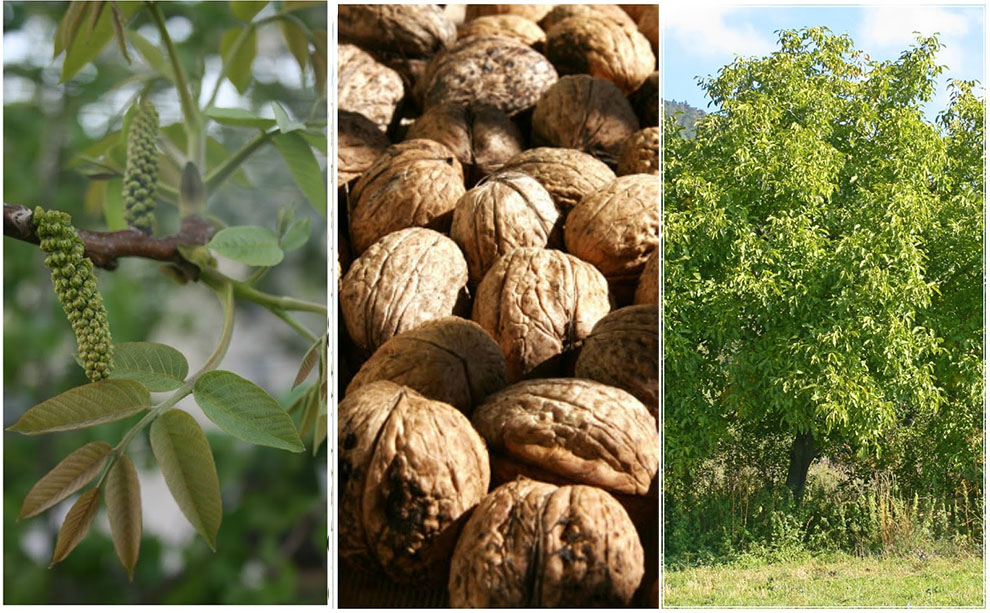
If you are learning how to plant walnut trees from seeds, don’t forget the fact that Walnuts yield a chemical compound called juglone. It may be toxic to neighboring plants and curtail their growth.
Plant the walnut away from sensitive plants and garden areas to mitigate its effects.
You can grow them in open spaces, away from flower beds or vegetable gardens, to reduce any negative impact on the nearby plants.
D. Should You Fertilize Walnut Trees When Planting Or Afterward?
When planting walnut trees, you must avoid feeding. Walnut trees have sensitive roots. Incorporating fertilizer during planting can damage or burn them. Hence, experts recommend waiting until the tree establishes, typically after the first growing season, before you can fertilize them.
What Diseases Do Walnut Trees Get?
Walnut trees can be susceptible to diseases like root rot, anthracnose, crown gall, walnut blight, and thousand canker disease. Walnut blight, caused by a bacterial pathogen, affects the fruit and leaves.
Anthracnose can cause leaf and twig damage. Crown gall affects the trunk and roots, while root rot can lead to root decay. Fungus infections lead to thousand canker disease, which affects the branches and trunk.
Proper care, regular monitoring, and appropriate treatment can help manage these diseases.
How To Grow A Walnut Tree In A Container?
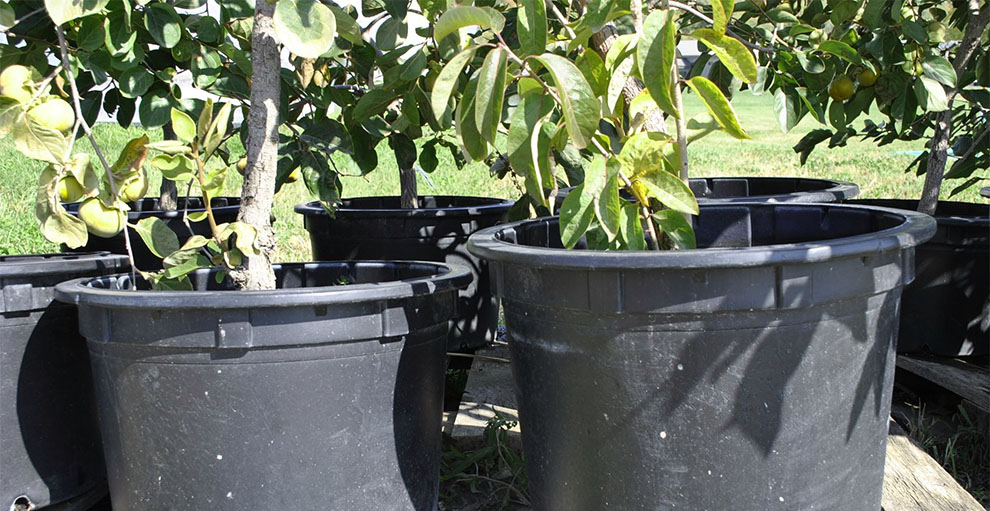
Growing walnut trees in a container need careful attention to ensure you provide the plant with suitable conditions for its development. You can follow the steps below:
- Pick a huge container with adequate drainage holes. It should be at least 20-20 inches in diameter.
- Fill it with well-draining soil rich in organic matter.
- Plant a grafted walnut sapling in the container, ensuring the bud union rests above the soil line.
- Move the pot to a sunny location to ensure the plant gets at least six hours of direct sun daily.
- Water deeply, but let the soil dry between the two watering.
- Fertilize with slow-release balanced plant food. Follow the packaging instructions to avoid overfeeding.
- Prune regularly to maintain size and shape.
- Inspect for pests and diseases.
- Offer winter protection if needed.
How Many Years Before A Walnut Tree Produces Nuts?
Most walnut trees take several years to reach maturity and produce nuts. The exact time may vary depending on factors like management practices, growing conditions, and the variety.
Typically, walnuts take five to seven years (sometimes more) to bear nuts. However, some species may take up to a decade to yield their first crop of nuts.
But once they produce nuts, they continue their yield for several decades with proper care and maintenance.
